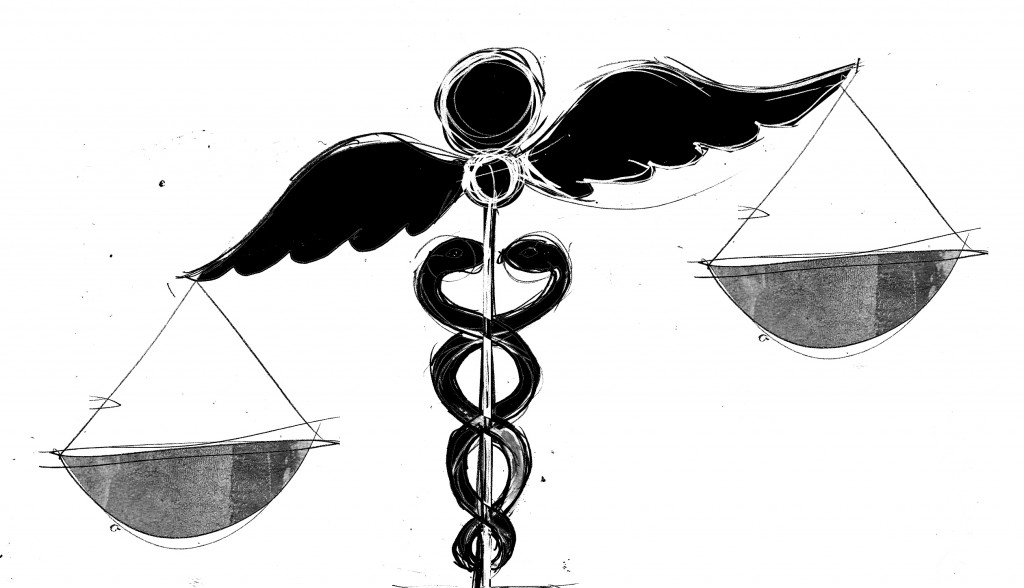It's a shame that I was writing about the dangerous situation with Ebola in Africa years before the national media noticed it. It's a shame that I have been shouting about the current epidemic in West Africa long before the national media noticed it. It's a shame that the national media and the American people seemed far more concerned about three cases of Ebola in the USA then the thousands and thousands in Africa. It's a shame that I seem to know more about how to deal with Ebola then the CDC or WHO. It's a shame that I have lost so much confidence in the CDC and WHO. It's a shame that the head of the CDC is just another political appointment, that WHO regional offices are political appointments. It's a shame that the workers at the CDC and the WHO don't have more say in their agencies. It's a shame that local health departments are for the most part incompetent. It's a shame that we are all told absolutes when there are no absolutes. It's a shame that few share the fact that we have never dealt with this particular strain of Ebola, that we have never dealt with an epidemic the size and scope of what we are seeing in West Africa, that we have never tried to contain Ebola in heavily populated area. It's a shame that Republicans see all this as an opportunity to push right wing politics, and Democrats think complaining now about budget cuts is the best they got. It's a shame that the best the government can do is hold hearings after the fact and appoint a Czar. It's a shame that the Czar they have appointed has less relevant experience then I do. It's a shame that until a couple of white Christian Americans contracted Ebola, that no one here much gave a damn. It's a crime that thousands are dying in Africa not primarily as a result of a virus but as a result of poverty and healthcare inequality. It's a shame so few seem to get the fact that the battle lines are now in Africa because what happens there will shape what happens everywhere else, and because it is there that people are dying in droves. It's a shame that Americans really believe that the way to deal with Ebola is to take people's temperature at the airport, and believe that they can really build a wall around their country in a globalized world. It's a shame that Americans, the media, the government don't get the fact that if Ebola explodes in the developing world that it will have a huge impact on the lives of everyone worldwide. It's a shame that governmental officials don't seem to understand how international trade, energy, food, etc., works in a global world. It's a shame that so many now want to blame Africans and nurses for what is happening. It's a shame that racism and stigmatization have reared their ugly heads yet again concerning an infectious disease. It's a shame and it is frightening that three cases of Ebola in the USA has panicked the nation, while the deaths of thousands of black Africans seem to mean nothing. It's a shame that only I seem to know and warn that Ebola is nothing compared to avian flu. It's a shame that as unprepared as the nation and world has seemed in response to the Ebola virus, its preparation for a just as lethal, and much more easily transmitted avian flu virus is a big bunch of nothing. It's a shame that Americans can't seem to learn to think beyond their own individuality. It's a shame that the finger of blame for so much of this is not being pointed squarely at Capitalism. It's all a shame.
SCISSION provides progressive news and analysis from the breaking point of Capital. SCISSION represents an autonomist Marxist viewpoint. The struggle against white skin privilege and white supremacy is key. --- "You cannot carry out fundamental change without a certain amount of madness. In this case, it comes from nonconformity, the courage to turn your back on the old formulas, the courage to invent the future.” FIGHT WHITE SUPREMACY, SAVE THE EARTH
Friday, October 17, 2014
EBOLA: IT'S A SHAME
It's a shame that I was writing about the dangerous situation with Ebola in Africa years before the national media noticed it. It's a shame that I have been shouting about the current epidemic in West Africa long before the national media noticed it. It's a shame that the national media and the American people seemed far more concerned about three cases of Ebola in the USA then the thousands and thousands in Africa. It's a shame that I seem to know more about how to deal with Ebola then the CDC or WHO. It's a shame that I have lost so much confidence in the CDC and WHO. It's a shame that the head of the CDC is just another political appointment, that WHO regional offices are political appointments. It's a shame that the workers at the CDC and the WHO don't have more say in their agencies. It's a shame that local health departments are for the most part incompetent. It's a shame that we are all told absolutes when there are no absolutes. It's a shame that few share the fact that we have never dealt with this particular strain of Ebola, that we have never dealt with an epidemic the size and scope of what we are seeing in West Africa, that we have never tried to contain Ebola in heavily populated area. It's a shame that Republicans see all this as an opportunity to push right wing politics, and Democrats think complaining now about budget cuts is the best they got. It's a shame that the best the government can do is hold hearings after the fact and appoint a Czar. It's a shame that the Czar they have appointed has less relevant experience then I do. It's a shame that until a couple of white Christian Americans contracted Ebola, that no one here much gave a damn. It's a crime that thousands are dying in Africa not primarily as a result of a virus but as a result of poverty and healthcare inequality. It's a shame so few seem to get the fact that the battle lines are now in Africa because what happens there will shape what happens everywhere else, and because it is there that people are dying in droves. It's a shame that Americans really believe that the way to deal with Ebola is to take people's temperature at the airport, and believe that they can really build a wall around their country in a globalized world. It's a shame that Americans, the media, the government don't get the fact that if Ebola explodes in the developing world that it will have a huge impact on the lives of everyone worldwide. It's a shame that governmental officials don't seem to understand how international trade, energy, food, etc., works in a global world. It's a shame that so many now want to blame Africans and nurses for what is happening. It's a shame that racism and stigmatization have reared their ugly heads yet again concerning an infectious disease. It's a shame and it is frightening that three cases of Ebola in the USA has panicked the nation, while the deaths of thousands of black Africans seem to mean nothing. It's a shame that only I seem to know and warn that Ebola is nothing compared to avian flu. It's a shame that as unprepared as the nation and world has seemed in response to the Ebola virus, its preparation for a just as lethal, and much more easily transmitted avian flu virus is a big bunch of nothing. It's a shame that Americans can't seem to learn to think beyond their own individuality. It's a shame that the finger of blame for so much of this is not being pointed squarely at Capitalism. It's all a shame.
Thursday, October 16, 2014
15M.cc: AUTONOMIA AND THE MULTITUDE (STARTS AS THREE?)
What can I do? What is autonomous action? How can we get anywhere without a vanguard party to lead us?
The post below gives an example of one the myriad answers to all of those questions. The multitude can and does always find new ways "to take charge of our life and start a change." This is exactly what a group of people in Spain have done...and they have done more. They have made sure that the voice of the multitude, the struggle itself will be known and will continue. They found a way.
This is something each of us collectively with others of us must and can do. The State can throw a lot at us. Global Capital can sometimes seem to simply overwhelm us. Neither can eliminate us and as long as we, the multitude, are around a new world, a better world remains on the horizon, maybe not today or tomorrow, but someday.
In Spain the 15M movement did not result in some organization with huge numbers of card carrying members. As Revolution News writes:
The 15M movement is a social movement. This means, it has served as a catalyst for “moving” social collectives, associations, non-mobilized people, initiatives… and in this sense it still exists today, as another step in the spiral of social reactivation. It radically changed the country’s political climate. The most visible consequences have been the success and victories of the PAH (Platform of those affected by mortgages – which already existed before), massive mobilizations against cuts – many organised in the so called “mareas” (social “waves” protecting healthcare, education, women’s rights, anti-repression, etc.), the strengthening of a thousand struggles, the creation of new initiatives building alternatives and solutions, organised legal actions against corruption and injustices and the building of self-support networks all around the state.
Just one part of the 15M movement is the 15M.cc,
In September 2011 an innovative project was launched with the aim of documenting and transmitting the myriad activities of the 15M movement to the widest audience possible. 15M.cc is an ongoing experiment in collaborative, transmedia and copyleft creation and, over the past eight months, the project has evolved in ways its three founders, Stéphane M. Grueso, Patricia Horrillo and Pablo Soto, could not have imagined.
Initially, the intention was to produce a documentary, a book and a website but, as the scope of the project widened, sister projects in Malaga and Seville were set up.
The 15M.cc website then became an umbrella for a cluster of 15M projects and the original idea of the project’s founders became Madrid.15M.cc. An important point is that 15M.cc does not represent the 15M movement; its purpose is to document and raise awareness about the movement and its rich ecology.
That is how it so often works when a few of us (15M.cc started with three people), or many of us begin something, we simply don't know where it will end. However, begin we must.
And that is why the State has no answer. How could they? An answer to what? You can't step on all of us.
After all as 15M.cc itself puts it:
This project, as we have explained since the beginning, is alive and open to changes as elements that can improve it keep coming up. The aim is managing to get each person into feeling 15M.cc hers or his as far as they can or want to, and participate in those areas in which they feel comfortable, collaborating on initiatives already happening or creating their own. The important thing is to build a community capable of creating as many more stories about 15M as possible.
This is what autonomia is all about.
I love this stuff.
The post below is from Autonomies and I hope you can view the video as well as read the information.
Unrepresentable stories: Films of resistance

Spain’s public prosecutor has recently asked for cumulative legal punishment of up to 74 years and 3 months for those involved in the initial disturbances that led to the acampada of the Puerta del Sol, in Madrid (2011), and the subsequent rise of the movement that came to be known as 15M. (Público 15/10/2014) This is but another expression of the politics of fear that the government has employed against the diversity of social movements that 15M has become. And it is paralleled by the effort to efface the memory of the movement, to retell its story in such a way that its radical possibilities are marginalised and silenced.
Against this, the multiple efforts to tell the radical story, and to keep making it real, become fundamental. In this way, the past does not pass away, but remains a permanent present.
We share below a documentary, 15M: Málaga Despierta, made by activists of Málaga15M.cc (part of the larger 15Mcc project), focusing on the movement in the andalusian city, along with the film’s manifesto.
Manifesto “15M: Málaga Awakens”
Two years ago, almost three after the start of the 2008 crisis, we all received a convocation through social networks for a social mobilisation. Yet another one, many of us thought. The apathy was already generalised. People continued to lose their jobs, their homes, their rights and, obviously, their illusions and their energy. However, we decided to go on hoping too. Nobody knew what was going to happen on this May 15, 2011 in the demonstration called by DRY [Democracia Real Ya], but the desire to support this call with the motto “We are not commodities in the hands of politicians and bankers”, we shared. We thought we were going to be the same usual four old faces. But we saw it as just, necessary and urgent to go into the street to make it obvious that we could no longer tolerate what we suffered, that we had to act. And thus our surprise that we were not alone! Thousands of people had decided they were also fed up. After this demonstration full of freshness, spontaneity, energy and outrage, some became depressed thinking that it was then time to leave. Again another useless demonstration? Again we are going to return home, to remain silent and alone? That organic character and spontaneity that accompanied this movement from the beginning led to a group of people deciding to stay in a square in Madrid. The morning of May 16, 2011, the light that thousands of people had radiated during the afternoon of 15 continued latently to shine amid the blankets of people who sustained the hope that something big could happen. The rest, we already know. A violent eviction led to the symbolic act of camping spreading, filling all of the squares of the country with hope. People of all ages came to the camps with firm proposals, wanting to work, wanting to change things. We were sleeping and suddenly woke up.
In Málaga, we also awoke. It was a Tuesday, May 17th. We reacted, as one has to in these cases, united and above all, believing that it was finally our chance to change the world. At first, some felt shyness and hesitation. We were not used to speaking in public about things that affect our daily life: economics, politics, law, social rights … We learned slowly, together, helping each other.
15M: Málaga Despierta is a story that happened in Málaga, but told with a universal message. The germ is the same as that of the 15M movement. We came to the square with a camera and a microphone to reflect what was happening. And little by little we were becoming more willing to contribute their faces professionalism, but above all his humanity to tell the story of the awakening of a generation.
15M: Málaga Despierta was already a seed from the first week of the acampada in Malaga. We arrived at the square to record images for Tere, a friend of Rakesh, who worked at a production company in Madrid and wanted to include sequences of Spain’s third largest camp. But, in addition to recording these images, the first week we had already decided we would do our own documentary. And in this new world of synergies, networks and solidarity brothers of 15m.cc from Madrid to tell us that they were going to start a collaborative and participatory project. It would be made with the voice of many, and assembly based. Copyleft. Pro-commons. Free. At the time we thought that this was the code we had to follow, the same we had learned in the squares since the 15th May. So we copy it.
In this way then the 15mMalaga.cc team begins to tell its own story and invites all citizens to share their contribution in the form of photographs, videos, music, creativity and knowledge in general. It’s been a year and a half of hard work. With zero budget and a great deal of creativity. With enthusiasm and energy, but also with crises and difficult moments. But we’ve been united, working together, and in the end we can say today that 15M: Málaga Despierta is a reality motivated by a desire to change things, for the regretful injustices that we daily know of and from which we’re becoming protagonists in our, for the solidarity and networks that have been created among us, now gathered to move in the same direction. We have awakened and will not return to sleep. As our dear José Luis Sampedro, godfather of this documentary, says “We have received a life, our duty is to live!”
We have told our story with the help of many voices. A story that happened in Málaga and has not yet finished: that continues to be written. A story with a universal message that we wish to share in many cities, countries and continents, across borders. We know that only by sharing can we continue to build. We know that the famous “Yes we can” of 15M can become a reality if we work together from the local and think globally.
So today we release this message on the network that we hope you will make yours. So that everyone can share it and we can go further. That’s always been our goal, equal to the slogan of 15M, “we move slowly because we are going far.” Let us continue writing together this story of change, which is ours! From Madrid, Malaga, Seville to Cairo, the West Bank, Reykjavik or Bogota we have awakened and are joined by invisible umbilical cords. We do not want to close our eyes. We have understood that now is the time to take charge of our life and start a change. We owe it to ourselves today, to the younger generation and older who already fought for our rights. So, let us follow the leitmotif of this movement, tell the story you really want to live!
Wednesday, October 15, 2014
EBOLA: ONE MORE STOP IN THE HISTORY OF RACISM, WHITE SUPREMACY, AND DISEASE
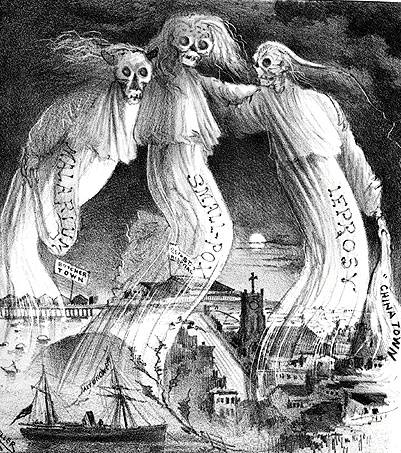 |
| Cartoon from The Wasp of May 26, 1882, promoting the then-common racist myth that diseases were rampant in Chinatown. |
I am not back.
No time, but I had to post this.
Racism and infectious diseases...today Ebola, yesterday and tomorrow something else. Listen to white supremacist on the net and on the radio and you will get sick to your stomach and want to punch someone out.
The following from Jezebel is a bit more refined, but right on target.
From Miasma to Ebola: The History of Racist Moral Panic Over Disease
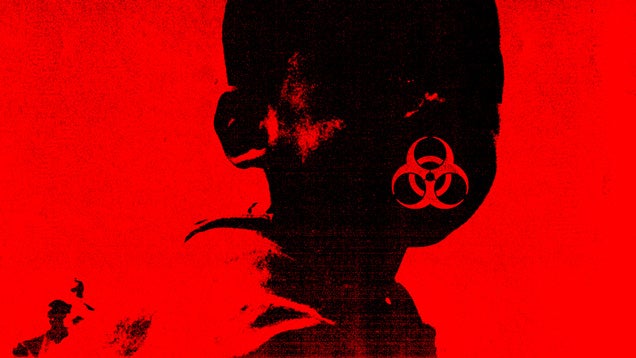
On October 1st, the New York Times published a photograph of a four-year-old girl in Sierra Leone. In the photograph, the anonymous little girl lies on a floor covered with urine and vomit, one arm tucked underneath her head, the other wrapped around her small stomach. Her eyes are glassy, returning the photographer's gaze. The photograph is tightly focused on her figure, but in the background the viewer can make out crude vials to catch bodily fluids and an out-of-focus corpse awaiting disposal.
The photograph, by Samuel Aranda, accompanied a story headlined "A Hospital From Hell, in a City Swamped by Ebola." Within it, the Times reporter verbally re-paints this hellish landscape where four-year-olds lie "on the floor in urine, motionless, bleeding from her mouth, her eyes open." Where she will probably die amidst "pools of patients' bodily fluids," "foul-smelling hospital wards," "pools of infectious waste," all overseen by an undertrained medical staff "wearing merely bluejeans" and "not wearing gloves."
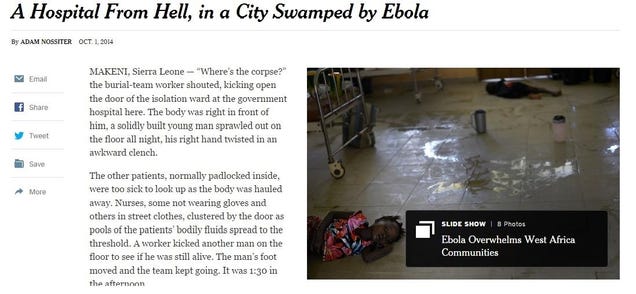 EXPAND
EXPAND
Aranda's photograph is in stark contrast to the images of white Ebola patients that have emerged from the United States and Spain. In these images the patient, and their doctors, are almost completely hidden; wrapped in hazmat suits and shrouded from public view, their identities are protected. The suffering is invisible, as is the sense of stench produced by bodily fluids: these photographs are meant to reassure Westerners that sanitation will protect us, that contagion is contained.
Pernicious undertones lurk in these parallel representations of Ebola, metaphors that encode histories of nationalism and narratives of disease. African illness is represented as a suffering child, debased in its own disease-ridden waste; like the continent, it is infantile, dirty and primitive. Yet when the same disease is graphed onto the bodies of Americans and Europeans, it morphs into a heroic narrative: one of bold doctors and priests struck down, of experimental serums, of hazmat suits and the mastery of modern technology over contaminating, foreign disease. These parallel representations work on a series of simple, historic dualisms: black and white, good and evil, clean and unclean.
The Western medical discourse on Africa has never been particularly subtle: the continent is often depicted as an undivided repository of degeneration. Comparing the representations of disease in Africa and in the West, you can hear the whispers of an underlying moral panic: a sense that Africa, and its bodies, are uncontainable. The discussion around Ebola has already evoked—almost entirely from Tea Party Republicans—the explicit idea that American borders are too porous and that all manners of perceived primitiveness might infect the West.
And indeed, with the history of American and European panic over regulating foreign disease comes a history of regulating the perception of filth from beyond our borders, a history of policing non-white bodies that have signified some unclean toxicity.
If the history of modernity can, as Dominique Laporte suggests in his genealogical meditationHistory of Shit, be written as a triumph of cleanliness over bodily refuse, then so too could the European colonization of Africa and India. The sanitary crusade of the nineteenth century is central to the violent project of empire. Western medicine, with its emphasis on personal hygiene, functioned (and in some arenas still functions) as colonialism's benevolent cover—an acknowledgment that, while empire was about profit at all costs, that it could also conceal this motive slightly by concerning itself with bettering the health of debased bodies.
The bureaucratic annals of colonialism are filled with reports on the unsanitary conditions of life and unhygienic practices of natives. Dr. Thomas R. Marshall, an American in the Philippines,wrote of the "promiscuous defecation" of the "Filipino people." An 1882 British report, "Indian Habits," observed that, "The people of India seem to be very much the condition of children. They must be made clean by compulsion until they arrive at that degree of moral education when dirt shall become hateful to them, and then they will keep themselves clean for their own sakes." Dirtiness and defecation indicated their primitiveness and savagery; it reaffirmed the white body's privileged position and claim to moral and medical modernity.
This intense focus on hygiene emerged from an old medical doctrine known as miasma. According to the miasma theory, illness was the direct result of the polluting emanations of filth: sewer gas, garbage fumes and stenches that permeated air and water, creating disease in the process. Filth, however, had many incarnations. It could be literal, or also a catch-all metaphorical designation for anything that made people uncomfortable about race, gender and sexuality. (This idea underpins phrases still in use today, for example: a "dirty whore").
So, the medical mission of hygiene was simultaneously a moral and medical imperative. And it was this fervent belief in miasmas that led to colonial administrations deeply interested in the bodily fluids of bodies of color; as Lord Wellesley, the British governor of India, briefly noted in an 1803 report, "Indians defecate everywhere."
But if colonial governments exercised concern over what they believed to be the contaminated cultures of native populations, it was more likely the result of panic over the health of their own officials and soldiers. "The white man's grave," as one nineteenth-century British colonist called Sierra Leone, was a dangerous trap of foreign disease, carried by the contagious peoples who inhabited valuable land. Their culture, like their natural resources, must be conquered. Who better to do that then scientifically advanced westerners who valued cleanliness and life?
Miasma theory proved a powerful science through which to construct "the African" or "the Indian." Long after its late-nineteenth-century demise and subsequent replacement with an epidemiological understanding of contagion, the metaphors it produced endured. The move from miasma theories to germ theories simply added pathological depth to older social resentments. Minorities might look clean: but who knew what invisible, contagious threats lurked within?
These stereotypes showed up everywhere. Take, for example, Victorian soap advertisements: ordinary markers of domesticity that, according to feminist scholar Anne McClintock, "persuasively mediated the Victorian poetics of racial hygiene and imperial progress." In a Pears' Soap advertisement from around 1882, race is linked to dirtiness and ignorance: blacks could become clean (here, actually, white) if they just bathed; they barely know how to clean themselves; they need a white man to teach them cleanliness, civilization, culture, etc.
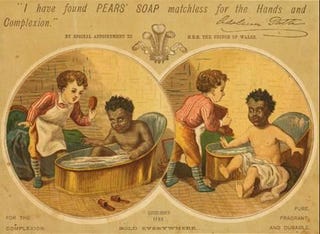 EXPAND1
EXPAND1
Such metaphors proved successful for Pears' Soap, and the company returned to triumphant colonial imagery time and time again. In another ad from the 1890s, a naval commander (likely a stand-in for Admiral George Dewey) is shown washing his hands; he is flanked by ships that import soap and a missionary anointing his dirty, savage subject with hygiene. Underneath the images, the text reads "The first step toward lightening The White Man's Burden is through teaching the virtues of cleanliness."
But if disease was the result of a certain kind of self-imposed debasement—of a choice to resist modernity—then the moral meaning of dirt was flexible. It could be external, a black body in need of hygienic instruction, but it could also be internal, the naturally occurring state of the nonwestern body. Miasma theory gave way to eugenics; filth was biologically determined, inside and out.
If filth provided European imperialism with a set of legible metaphors about disease and race, then it also gave a newly-forming United States racial principles on which to build a national identity. With institutionalized slavery and a relatively open immigration policy, America, more so than Europe, needed those metaphors to preserve the cultural and moral superiority of particular kind of whiteness (a Teutonic Northern European whiteness). In the late-nineteenth and early-twentieth centuries contagious disease was associated with new immigrant groups who were perceived as harbingers of death.
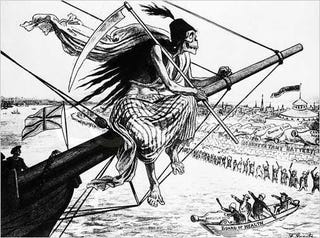 EXPAND
EXPAND
Nativist groups warned the public of disease that would infect the nation's growing urban areas, rationalizing their prejudice with arguments about public health. In the 1830s, poor Irish were said to bring cholera; at the turn of the century, tuberculosis was dubbed the "tailors' disease" and associated with the Jewish population; Italians for decades were seen as bearers of polio.
To protect against immigrant germs, the United States passed the Immigration Act of 1891, an act that excluded those with "criminal records, polygamist, and prostitutes," as well as those with "loathsome or contagious disease." The Immigration Act made clear that the immigrant carried the filth of both moral degradation and disease. The definition of "loathsome and contagious disease" was flexible and ever-changing, including everything from transmissible disease to insanity, senility, varicose veins, and poor eyesight.
The truth, of course, was that immigrants groups were as healthy as acceptably white Americans.According to contemporary legal scholars, less than three percent of the total number of immigrants seeking entry were rejected for medical reasons; the vast majority of those excluded were Chinese who, unlike their white counterparts, could be rejected for ringworm and "the appearance of mongolism." But yet, despite these facts, white Americans still clamored to close the borders entirely. An 1888 federal report calling for even more immigration restriction warned of the "sewage of vice and crime and physical weakness" that washed ashore from Europe and the "nameless abominations" coming from Asia.
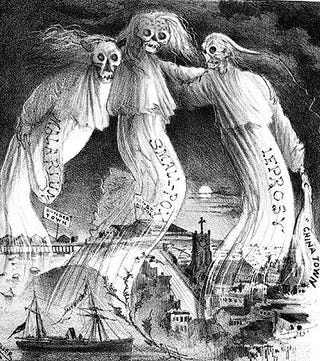 EXPAND2
EXPAND2
The language of the 1888 report is similar to the current, persistent calls to close our borders. Both rely on the intertwining metaphors of illness and filth. This, of course, is how the metaphor of disease works. Susan Sontag has written of the hierarchy of disease, of death in a western context. She notes that there are brave and beautiful ways to die, diseases that afflict and kill, yet reveal a beautiful, meaningful self. And the diseased body of white Europeans, particularly the wealthy, is rarely depicted filthy or debased. Rather, that body becomes the source of poetic meaning; think of Henry James's The Wings of the Dove (1902) or Thomas Mann's The Magic Mountain (1927) a novel that describes disease as "nothing but a disguised manifestation of power of love; and all disease is only love transformed."
Perhaps nowhere was the power of a disease metaphor more evident than in San Francisco in 1900. When a Chinese immigrant was found dead in the basement of a Chinatown hotel, rumors spread immediately that he had died of the plague. Before the diagnosis was confirmed, the mayor quarantined Chinatown, preventing anyone of Asian origin from leaving the district while allowing whites to move around freely. Once the diagnosis was confirmed, the city's white residents panicked. The Board of Health demanded the entire district be doused in lye and bichloride of mercury, that clothes and furniture be burned, that every person of Asian descent be vaccinated with something called Haffkine's serum, which had not yet been approved for human use. Newspapers called for Chinatown to be emptied of its residents and burned to the ground.
The measure the city took were in direct opposition to those recommended by health officials. Quarantining an entire population and dousing them with household cleaners made the outbreak worse. The outbreak of plague ended when state health officials stepped in, but the panic served its purpose: it reaffirmed old suspicions that Chinese immigrants were dangerous, and that their foreign lifestyle could easily soil San Francisco's urban modernity.
The plague broke on again in San Francisco, after the 1906 earthquake, but this time it wasn't in Chinatown; it emerged from an overwhelmingly white city district. There was no quarantine, no dousing of the city with lye. Rather, the city spent two million dollars to provide free and sophisticated medical care, and the death toll was much smaller.
Returning to the four-year old Ebola patient in the New York Times: The photograph of a dying little girl is simultaneously a site of sympathy and a powerful reminder of the contagion she carries. As she dies from a vicious, seemingly unstoppable disease, the photograph is meant simultaneously to warn and console. Look at this cesspool, these unsanitary conditions; she is foreign, Ebola is foreign. This scene is by no measure the only scene of healthcare in African countries, but it is often the only scene we see.
This underlying sense of foreignness underlies the way we see Ebola in the United States.Newsweek repeated these ugly stereotypes in an August cover story that conspiratorially suggested that illegally imported African "bushmeat" could carry Ebola into our borders (a story that's been thoroughly debunked).
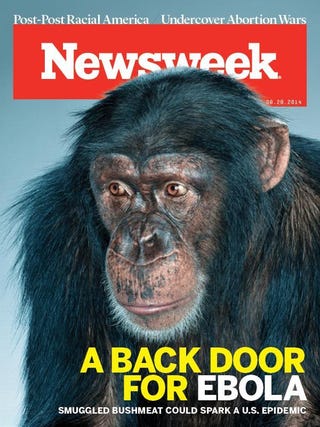 EXPAND
EXPAND
And when the Centers for Disease Control and Prevention confirmed that Ebola had crossedinto the United States, carried on the body of a black man from Liberia, the threat of infection was suddenly perceived as quite real. Rumors flew that Ebola had reached Idaho, then Miami, that the disease was airborne, and that a sick passenger on a flight to New Jersey was infected. Television and radio host quizzed CDC physicians about the likelihood of infection ("little to none," they seem to answer again and again), asked again about the safety of our too-porous borders, demanding that our government outline a plan of action to ward off infectious, black bodies.
Thomas Duncan, that Ebola patient, is now dead. He sought treatment five days after returning to the US, telling the hospital that he had traveled to Liberia and was experiencing a fever and abdominal pain. With no insurance, he was turned away. A Washington Post story reports that some people close to him feel that he was "not properly treated because he was not American."
"He is a Liberian man," Massa Lloyd, a close friend of Troh, said Wednesday. "The family feels he wasn't getting the right treatment because he was an African man. They feel America is fighting only for the white man, not the black man."
The onset of epidemic disease has always incited prejudice, permitting the stereotyping of foreigners, of people of color, as inherently closer to disease: more deserving of death from it. The "always them, never us" conception of Ebola is a major factor in the lack of a vaccine, which the NIH has been researching, with dwindling funding, since 2001. The new presence of Ebola in the US may change the way we approach the virus, but maybe not; maybe it will always seem too foreign for us to handle it like the global and communal problem that it is; maybe, disastrously, this outbreak of Ebola will be no different than before.
Stassa Edwards is a freelance writer and editor.
Image by Jim Cooke, source photo via Getty.
Subscribe to:
Comments (Atom)
